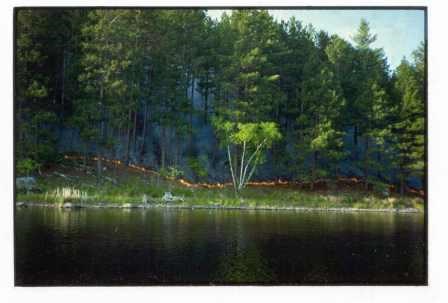
NPS Why do you burn? As explained in the Prescribed Fire section, the park burns for a variety of reasons. The main ones are to reduce hazardous fuels, and restore and maintain ecosystems. The park uses fire to consume fuels (e.g. burnable vegetation) thereby reducing the intensity of future fires making them easier to control and allowing firefighters to more easily protect structures and other resources. Fire is also being used for the long term maintenance of the parks pine stands. Without fire, these stands will be replaced by brush and hardwoods, and in less than 200 years very few, if any of these stands will remain.
What and where do you burn? The park targets those stands that are near resources the park intends to protect, such as buildings, campgrounds, and historic locations. The park also targets forest stands that are in need of restoration. These are typically red and white pine stands though some oak and jack pine stands are also identified.
What determines when you burn? There are several conditions that must be met before a site can be burned. These are indirectly and directly based on weather, in the form of calculated indices and direct measurements of wind, temperature, and relative humidity. The indices used come from the Canadian Forest Fire Weather Index. Limits for the indices and weather conditions are predetermined in the planning stage and these limits regulate if and when a prescribed fire can take place. Who conducts the burning? Prescribed fires are conducted by park staff with assistance from Fire Use Modules and cooperating state and federal land management agencies. A Fire Use Module is a group of fire fighters who spend most of their time preparing sites for and conducting prescribed fires. Does it matter in which season you burn? Yes, it matters a lot. Most prescribed burns in the region are conducted in the spring, as is the case at Voyageurs. In the spring the duff (the composted layer between the needle cast and the soil), and the larger fuels (logs and sticks) are still wet and therefore are not consumed during the fire; only the needles and finer twigs are consumed. Small to medium balsam firs are killed outright, and shrubs and smaller hardwood trees are top-killed, meaning they will re-sprout. Spring burns are often conducted to reduce the fuel load a little at a time, since all the fuel is not available to burn the intensity of the fire is limited. Summer, or growing season burns, are more natural in that they tend to burn for longer periods and summer is historically the time when most fires occurred due to the frequency of lightning. From a restoration standpoint summer burns are better at achieving the long-term goals. Since most of the duff is dry enough to burn, summer burns are more effective at exposing mineral soil and killing invading shrubs and hardwoods. This creates the necessary conditions for pine seed germination and long term survival of the seedlings. Summer burns are conducted at Voyageurs for these reasons and are often preceded by spring burns to help limit the intensity. Why are you killing all the trees? Though red and white pine trees have thick fire resistant bark, individual trees and groups of trees are often killed during prescribed fires. As unappealing as this is, the death of these trees is completely natural and absolutely necessary for the long term persistence of pine stands. Red and white pine stands naturally regenerate in openings created by intense fire. The adjacent live trees provide the seed for the new stand ensuring the persistence of the species on the site for another generation. Without the death of some over-story trees no regeneration can take place, and without regeneration pine will not persist on the site past the lifespan of the occupying cohort.
Couldn't the trees be better used for paper or lumber rather than allowing them to be burned? Aside form the fact that commercial harvesting is illegal in National Parks and Wilderness Areas, the question of "best use" is somewhat a matter of opinion. As such, managers of public land attempt to accommodate all desired uses within the mission of their agency. From a scientific and aesthetic point of view, the preservation of areas that are "untouched" by man is desirable. From an ecological perspective, burned trees serve many purposes providing nesting habitat for birds and small mammals, shade for developing seedlings, and long-term storage of nutrients, which are released as the forest grows. |
Last updated: December 15, 2022
